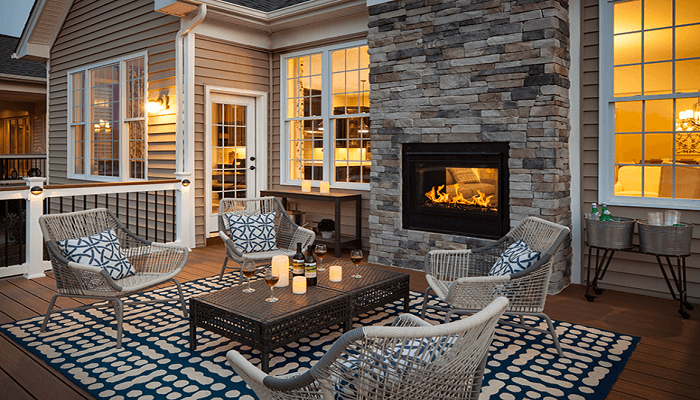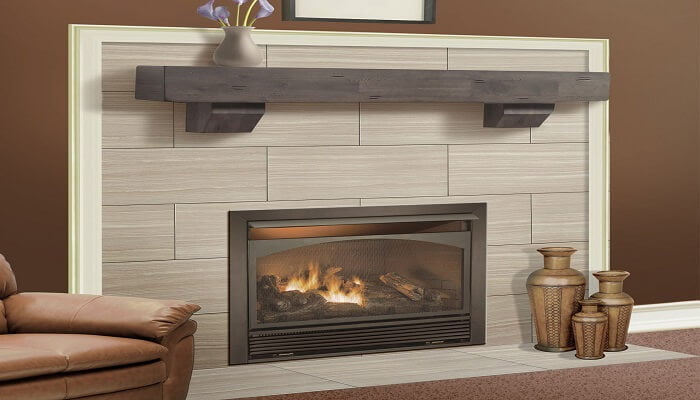How To Build An Indoor Fireplace Or Install?
Note: This article may contain affiliate links, which means if you make a purchase following our links won’t cost you extra, but we may earn a commission. Learn more
A fireplace is a structure made of brick, stone, or metal that is designed to control fire. It can also be called an open area built into the structure of a house, where fires can safely generate heat, and create a comfortable warm environment by heating the house.
The structure of the fireplace is such that if it is placed in the right place and the chimney is installed, it will be a blessing for you in the cold. So it is better to use the fireplace as the focal point of the house without using any room.
Historically a fireplace has been used for laundry, cooking, water heating, and domestic use. But the design of modern fireplaces is much improved, and its use has multiplied efficiently.
This use depends only on the design and placement of the fireplace. One type of fireplace for design is suitable for indoor use, and another type of fireplace is suitable for outdoor use.
In this article, we will discuss how to build and install an indoor fireplace.
How to Build an Indoor Fireplace?

Indoor fireplaces come in a variety of shapes and sizes but they are smaller than outdoor ones. You will also find different designs of fireplaces. Usually, these fireplaces fall into three categories: masonry, zero clearance, and gas. Each design has different features and advantages.
Again, one has to face different challenges for the features of different fireplaces. So before you learn how to build a fireplace you need to consider in detail the mentality of dealing with the challenge, your aesthetic knowledge, your home construction method, and your architectural style.
How to Build a Masonry Fireplace?
A masonry fireplace is a traditional and impressive-looking attractive fireplace. However, it is the most expensive option. When a person imagines a fireplace, it first comes to mind. This type of masonry fireplace has a brick or stone firebox and a brick or stone chimney. It should be careful to use the chimney, and the correct chimney should be installed perfectly. Otherwise, the downdraft will ruin your warm comfort.
1. Make a Plan
The main problem with this fireplace is that installing an existing home presents more challenges, but it is not impossible. It is best to set up a fireplace like this when the house is newly built.
The main advantage of building this fireplace is that you can customize the shape and size to your liking.
Different types of bricks and stones enhance the overall look and beauty of the house. The plan requires the selection of fire-resistant bricks in the selection of bricks.
2. Laying the Foundation
Masonry fireplaces are usually heavier than other fireplaces. A cement base should be sufficient for this extra weight. The depth will depend on the size and weight of your planned chimney. As such, the base of a masonry fireplace should be wider to accommodate how heavy it is.
The rule of thumb is to make a foot at least 12 inches thick for a two-story house and an eight-inch foot for at least a one-story house. Adjust these dimensions to each specific fireplace. If you are unsure about how big that base should be, you should contact a professional experienced mason.
3. Structures the Fireplace
The size of the fireplace will vary, but the masonry fireboxes have the same proportions. It should be at least four inches thick and twenty inches deep. Brickwork must be strong enough to hold any decorative stone or other material used on the exterior.
Usually, building codes vary but allow two inches around the wood frame or floor and brickwork like any combustible material. Vacancies need to be filled with some non-combustible material. When installing the brickwork make sure the bricks are evenly spaced.
When the fireplace is high enough, start installing flue tiles and seal them with mortar. The chimney should be at least four inches between the four sides of the brick and a flue tile.
4. Place the Chimney Cap
When the internal structural work is done, put on the chimney cap. Many do this generously, which should not be done at all. It is the cover at the top of the chimney that prevents birds and larger debris from entering.
You should choose a high-quality cap and make sure that it is working properly. High-quality caps contain galvanized metal, copper, or stainless steel. If you have a good budget, you can choose stainless steel or copper for maximum durability.
5. Final Touches
At this stage, your masonry fireplace will be structurally finished. There are various options for masonry fireplaces such as paint or exposed brick, but the most popular is a stone veneer.
Dry all the mortar first, then start working on the stone veneer. Because it can clean the fireplace properly.
After placing all the stones properly, a mortar bag can be used as a piping line for cake icing to compress the mortar into lines and cracks.
Zero-clearance Fireplaces Installation

Zero-clearance fireplaces can be easily installed by adjusting to the size and choice of your home. It is less expensive and easier than masonry fireplaces. Modern versions of these fireplaces have up to 70% efficiency.
Get a lot more heat than others. For rooms of any size, but especially for small rooms, homeowners consider zero-clearance fireplaces to be an intelligent and satisfying option.
If you want, you can sit directly within a few inches of the existing wall of your house. No special arrangements are required for this. To place zero-clearance fireplaces, first determine the width and length of your room (optimal size in inches).
Then combine those measurements by selecting a model to open in one-inch measurement for every foot. As you may know, zero-clearance fireplaces are already built as a code of up, which means you no longer have to worry about unexpected changes in size or design.
This does not require or require the installation of a buffer zone, so prefabricated fireplaces will fit in smaller spaces than other units. It has some models that are suitable for even mobile home installation.
Gas Fireplace Installation
The most popular fireplace for indoor use is gas. It is a hassle-free, smokeless and eco-friendly fireplace. A wood-burning fireplace can contaminate the environment. But a gas fireplace does not pollute. These models have thermostatic controls, which enable the homeowner to control the fireplace and make it more efficient.
Connect to the gas supply line for the main installation and ensure an adequate venting mechanism. Place your fireplace near a propane or natural gas line, where an extension can be run. The second requirement is vent opening, which you can easily do by installing it in an existing chimney or a new chimney. Follow the steps-
Step 1. Select and prepare the site for the fireplace installation.
Step 2. Now cut the hole through the walls of the outer room and install the stove pipe.
Step 3. Attach a small portion of the stove pipe to the exhaust port at the back of the fireplace.
Step 4. Apply construction glue around the top wall of the fireplace opening.
Step 5. Mark the glue around the fireplace opening and press the granite slab into it.
Step 6. Make sure the stovepipe runs out through the thimble, then slide the fireplace into position.
Step 7. Seal the outer part of the exhaust pipe.
Step 8. Make a gas connection to the fireplace
Step 9. Install a removable front in your fireplace.
Step 10. Turn on the fireplace and check.
If you can’t do things carefully, don’t take the risk, hire a licensed plumber.
Is It Safe to Have an Indoor Fireplace?
An indoor fireplace can be a great addition to any home. They provide both warmth and a focal point for any room. However, there are some safety concerns that need to be considered when using an indoor fireplace.
The first concern is the risk of fire. If the fireplace is not properly maintained, there is a risk of the fire getting out of control and causing damage to the home. It is important to have the fireplace regularly inspected and cleaned to reduce the risk of fire.
Another safety concern is the risk of carbon monoxide poisoning. If the fireplace is not properly ventilated, carbon monoxide can build up and cause serious health problems. It is important to make sure the fireplace is properly ventilated to avoid this problem.
Frequently Asked Questions (FAQs)
What Are the Benefits of an Indoor Fireplace?
Indoor fireplaces offer a number of benefits, including increased warmth, ambiance, and value to your home.
Can You Have an Indoor Fireplace Without a Chimney?
You can have an indoor fireplace without a chimney by using a direct vent fireplace. Direct vent fireplaces draw their combustion air from the outside and exhaust all of their fumes to the outside as well, so there is no need for a chimney.
You can have an indoor fireplace without a chimney by using a special type of insert that is designed for that purpose. These inserts are vented through the side of the unit and out through an exterior wall.
How Do I Care for My Indoor Fireplace?
It is important to follow the manufacturer’s instructions for your specific fireplace. In general, however, you will need to regularly clean the fireplace and chimney, and inspect the fireplace for any damage.
What Are the Safety Considerations for Indoor Fireplaces?
As with any type of fire, there are certain safety considerations to keep in mind with indoor fireplaces. Be sure to follow all manufacturer’s instructions and have your fireplace regularly inspected by a professional.
How Do I Choose the Right Indoor Fireplace for My Home?
There are many factors to consider when choosing an indoor fireplace, including size, fuel type, and style. The best way to determine which option is right for your home is to consult with a fireplace expert.
Conclusion
The use of indoor fireplaces is increasing day by day. Innovation in the production of this fireplace has also been adapted to human needs. You have to be very careful about its best use. If you build and install a fireplace properly in the beginning, you can protect yourself and your family from many fire hazards.
Related Post:
To see our latest posts Click Here
